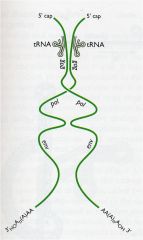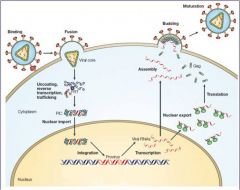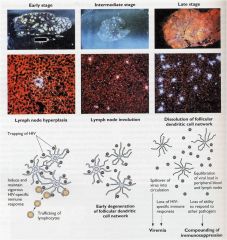![]()
![]()
![]()
Use LEFT and RIGHT arrow keys to navigate between flashcards;
Use UP and DOWN arrow keys to flip the card;
H to show hint;
A reads text to speech;
21 Cards in this Set
- Front
- Back
|
Identify the key components of the retrovirion (envelope glycoproteins, core, RNA strands etc)
|
Envelope glycoproteins (gp120, gp4)
core RNA strands reverse transcriptase RNase H integrase protease |
|
|
Identify the envelope glycoproteins and what they do.
|
gp120 binds to the CD4 of macs and this exposes another binding site on gp120 that allows it to bind to CCr5. gp120 moves out of the way and then gp41 enables fusion of the virion with the cell membrane
|
|
|
What proteins make the core of the HIV virion?
|
gag is what forms the 'bullet shaped' core which is necessary for virion maturation
|
|
|
What is the importance of RNase H, protease, integrase and RT
|
RT (reverse transcriptase) makes the DNA, RNase H chops up the old RNA, integrase inserts the newly formed DNA strand into the host genome and protease chops up gag to form the viral core
|
|
|
Describe the genome structure of a simple retrovirus and identify the products of gag, pol and env
|

gag makes the viral core
pol makes the polymerase env makes gp120 and gp41 (both of which are trimeric proteins |
|
|
Describe the replication cycle of the retroviruses
|

|
|
|
State the consequences of proviral DNA integration into the host genome
|
Once integrated into the host genome, the viral DNA does not leave. It can cause a number of different things depending on where it inserts. If it inserts just after a promotor or oncogene it will be heavily transcribed. It can also screw up a gene if it is inserted in a coding strand.
One example is in chickens where the progeny develop B cell lymphoma because of the integration of a retrovirus next to an oncogene. |
|
|
Describe the major feature and functions of the long terminal repeats (LTRs)
|
The LTRs are partially transcribed into an RNA intermediate, followed by reverse transcription into complementary DNA (cDNA) and ultimately dsDNA (double-stranded DNA) with full LTRs. The LTRs then mediate integration of the retroviral DNA via an LTR specific integrase into another region of the host chromosome.
|
|
|
Describe similarities and differences between the genomes of the simple mammalian C-type
retroviruses and the more complex HIV genome |
Simple retroviruses carry gag, pro, pol and env, however HIV carries accessory genes that control its pathogenicity (gag, pro, pol, env + TAT, REV plus more)
|
|
|
Describe Clades
|
HIV developed into two groups M (main) and O (outlier). The M group is divided into two clades, B (US and Europe) and E (mainly Thailand)
|
|
|
Identify the routes of tropism of HIV and HTLV
|
HIV binds to CCr5 on macrophages and CXCr4 on T Cells - the binding preferences depend on the variation of gp120 on the virus.
|
|
|
Describe the role of tat and rev
|

tat and rev are important in that they are part of the controlling factors of HIV's pathogenicity.
After HIV has been integrated into the cell DNA NFkB may eventually bind to its LTR and cause transcription. gag, pol, env are made along with tat and rev. tat re-enters the nucleus and causes increased transcription of the HIV genome and rev is responsible for bringing HIV transcripts out of the nucleus and into the cytoplasm for translation. |
|
|
Identify the cellular targets of HIV infection and the consequences of their depletion
|
HIV targets macrophages and CD4+ T cells. By targeting CD4+ T Cells it is able to weaken and evade and modify immune responses
|
|
|
Describe symptoms of HIV infection
|
Initial infection with HIV results in mild symptoms of lymphadenopathy, fever, fatigue (T cells drop, and may rebound slightly but never recover to previous levels).
When CD4+ T Cells fall below 500 cells/ul AIDs related sympytoms appear: oral lesions, basal cell carcinomas, latent activation of herpes and mycobacteria infections When CD4 levels fall below 200 more severe symptoms occur: protozoal, fungal, bacterial infections, viral infections and malignancies (Kaposi sarcoma), neurological disorders (AIDs dimentia). |
|
|
Describe how prolonged infection disrupts lymph node architecture
|

It eventually results in permanant immunosuppression
|
|
|
Describe late stage symptoms of HIV infection
|
|
|
|
Describe late stage symptoms of HIV infection
|

Pneumonia, Kaposi sarcoma, CMV retinitis, oral leukoplakia
...and viral/bacteria/protozoal infections |
|
|
Contrast HIV and HTLV effects on the CD4+ T cell and on virus-induced disease
|
HIV and HTLV have similar transmission patterns and are both common. However HTLV is a much slower virus and only 1% of infected people actually get the disease... and it takes 20 years to cause it.
HTLV also causes leukemias (it doesn't kill T Cells but rather immortalizes them) and does not encode a "classic" viral oncogene... HTLV does this via the Tax proteins which stimulate the T cell to make cytokines that cause its proliferation |
|
|
List two methods for diagnosis of HIV infection
|
Guesses...
Viral load, CD4 count? |
|
|
Describe HAART
|
Highly Active Anti-Retroviral Therapy uses a combination of RT (blocks RT) and protease (blocks capsid morphogenesis) inhibitors .
|
|
|
Why is HAART important?
|
HAART is needed to keep the viral load low (which helps to prevent drug resistant mutations from forming).
Maintaining a lower viralogic set-point slows the disease progression. Note - it is required the HAART usage be prolonged (indefinitely really) because the latent cells can live for such a long time... some for hundreds of days. |

